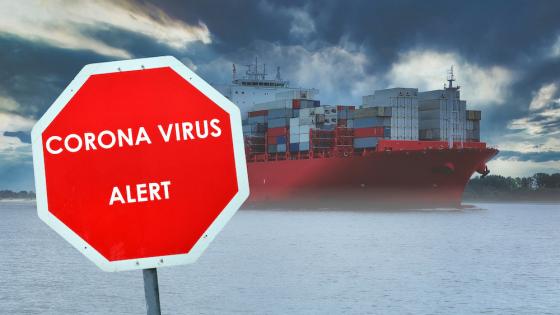On 26 and 27 February 2020, 175 executive managers attended a biotech conference in Boston, Massachusetts. An event that normally would have been praised as an example of the marvels of globalisation ended up spreading the COVID-19 virus to at least six states in the US and three European countries and caused nearly 100 infections in Massachusetts alone (Stockman and Barker 2020). Of course, this example is by no means unique; accounts of contagion through international business travel are common for the current health crisis and throughout history. In fact, the word "quarantine" originates from the Italian word "quarentena", a 40-day period of isolation required of ships and their crews during the Black Death pandemic.1
In a new paper (Antràs et al. 2020), we develop a new framework to study the two-way interaction between globalisation and pandemics. In our framework, households choose the number of varieties to source from each country. Sourcing these varieties involves interactions with other households, which create the threat of infection.
We show that this framework provides joint microfoundations for both the canonical model of international trade from economics (the gravity equation) and the seminal model of pandemics from epidemiology (the Susceptible-Infected-Recovered, or SIR, model). By jointly modelling these two phenomena, we highlight a number of interactions between them.
On one hand, the contact rate among individuals – which is a central parameter in benchmark epidemiology models – is endogenous in our framework and responds to both economic forces (e.g. the gains from international trade) and to the dynamics of the pandemic (e.g. the perceived health risk associated with international travel).
On the other hand, we study how the emergence of a pandemic and the perceived risk of future outbreaks shape the dynamics of international trade and the net gains from international trade once the death toll from the pandemic is taken into account.2
To trace the rich interactions between globalisation and pandemics, we first focus on a case in which globalisation affects pandemics, but pandemics do not feedback to affect globalisation. We do so by assuming that agents are unaware of the threat of infection and there are no deaths from the disease.
Second, we allow for general equilibrium feedback from pandemics to globalisation by allowing for deaths from the disease, while maintaining the assumption that agents are unaware of the threat of infection.
Third, we allow for both general equilibrium and behavioural feedback to globalisation, by allowing agents to become aware of the threat of infection and the risk of death from the disease.
In the first step, we find that even if agents are unaware of the threat of infection and there are no deaths, globalisation influences the dynamics of the disease because it changes patterns of human interaction. In particular, we show that there are cross-country epidemiological externalities, such that the condition for a pandemic to occur in the global economy (a global reproduction rate, R0, greater than one) depends critically on the disease environment in the country with the highest rate of domestic infection.
Therefore, even if a country has a healthy disease environment and would not experience a pandemic in the closed economy (because it has a domestic R0 less than one), it can experience a pandemic in the open economy if its trade partner has an unhealthy disease environment (that leads to a global R0 greater than one).
Perhaps surprisingly, these epidemiological externalities imply that a reduction in trade or mobility frictions can make a pandemic either more or less likely and can make a pandemic either more or less severe when it occurs.
If countries are sufficiently similar to one another, globalisation increases the prevalence and severity of pandemics. In this case, a common decline in barriers to international trade or the mobility of people increases the overall number of human interactions (domestic plus foreign), which in turn leads to increased disease transmission.
We illustrate this in Figure 1 for a world of two countries and symmetric reductions in mobility frictions (values of μ12=μ21).3 As trade or mobility frictions fall towards one, the resulting increase in overall human interactions raises the global R0. As this global R0 rises above one, the percentage of people infected during the pandemic (and recovered at the end of the pandemic) increases sharply in both countries.
Figure 1 Lower trade or mobility costs can create pandemics (symmetric countries)
Notes: Figure shows reductions in mobility costs (values closer to one are lower mobility costs); left axis shows the percentage of people who were infected during the pandemic and are recovered at the end of the pandemic; right axis shows the global R0; vertical line shows the value of mobility costs at which the global R0 exceeds one and a pandemic occurs.
If countries are sufficiently different from one another in terms of their primitive epidemiological parameters (for example, as a result of different health policies), globalisation can reduce the prevalence and severity of pandemics. In a case where one country has a much worse disease environment than the other, trade liberalisation can reduce the share of that country’s interactions that occur in this bad disease environment, thereby taking global R0 below one.
We illustrate this in Figure 2, again for a world of two countries, where country one is a healthy country (with a low infection rate) and country two is an unhealthy country (with a high infection rate). The figure shows the effect of reductions in symmetric mobility frictions (values of μ12=μ21). As mobility frictions fall towards one, more of the unhealthy country’s interactions occur abroad in the healthy country, which naturally reduces the percentage of its population infected during the pandemic.
Figure 2 Lower trade or mobility costs can prevent pandemics (asymmetric countries)
Notes: Figure shows reductions in mobility costs (values closer to one are lower mobility costs); left axis shows the percentage of people who were infected during the pandemic and are recovered at the end of the pandemic; right axis shows the global R0; vertical line shows the value of trade or mobility costs at which the global R0 exceeds one and a pandemic occurs.
Somewhat surprisingly, the fact that more of the unhealthy country’s interactions occur abroad can even reduce the percentage of the healthy country’s population that is infected during the pandemic (as observed for mobility frictions below 1.5). This is true even though this healthy country receives more visitors from the unhealthy country as mobility costs fall. The reason is that redistributing the interactions of the unhealthy country from its bad domestic disease environment to the good foreign disease environment reduces the severity of the global pandemic. Similar examples can be found for reductions in trade frictions.
Moving now to the second step of our analysis, we allow the infection to cause deaths (or reduce productivity in the labour market) but assume that agents remain unaware of the threat of infection and, hence, continue to have no incentive to alter their individual behaviour.
In this case, a country with more infections experiences more deaths, which leads to a reduction in its relative supply of labour and an increase in its relative wage. This relative wage increase reduces the share of interactions that occur in the country with more infections, which again can take the global economy below the threshold for a pandemic to be self-sustaining.
Therefore, the general equilibrium effects of the pandemic on wages and trade patterns induce a form of general equilibrium social distancing from unhealthy countries that operates even in the absence of purposeful social distancing motivated by an awareness of the threat of infection.
Finally, turning to the third step of our analysis, we allow households to become aware of the threat of infection and the risk of death (Farboodi et al. 2020, Toxvaerd 2020). In this case, when choosing how many interactions in which to engage to source varieties from each country, households internalise the probability that they will become infected and die. As a result, agents engage in purposeful social distancing, in which they reduce their interactions and the number of varieties that they source from a country with more infections. This reduction in the number of varieties leads to a reduction in the relative demand for labour in that country and a decrease in its relative wage.
The reduction in interactions and the number of varieties sourced in response to the threat of infection leads to a rise in the price index (the cost of living) in both countries. Since foreign interactions are subject to international trade frictions, they are relatively more costly than domestic interactions. As a result, when households engage in purposeful social distancing, they cut back more on the relatively high-cost foreign interactions, which leads to a large fall in the ratio of trade to income in both countries.
Introducing these behavioural responses is central to generating large reductions in the ratio of trade to output and implies that the pandemic has substantial effects on aggregate welfare, both through deaths and through reduced gains from international trade. Nevertheless, even after the introduction of adjustment costs, our model predicts a fast recovery of international trade after the pandemic is ended.
Globalisation and pandemics interact in several other interesting ways that we discuss in Antràs et al. (2020). For example, we show that international trade and mobility can lead to multiple waves of infections even without government-mandated lockdowns.
The richness and plausible relevance of the interactions we uncover deserve, we believe, more analysis and an empirical quantification. They may be important to improve the design of more resilient policies for a globalised world in which pandemics are a more frequent occurrence.
References
Antràs, P, S Redding and E Rossi-Hansberg (2020), “Globalization and pandemics”, NBER Working Paper 27840.
Cuñat, A, and R Zymek (2020), “The (structural) gravity of epidemics”, Covid Economics 17: 153–73.
Farboodi, M, G Jarosch and R Shimer (2020), “Internal and external effects of social distancing in a pandemic”, Covid Economics 9: 22–58.
Stockman, F and K Barker (2020), “How a premier US drug company became a virus ‘super spreader’”, New York Times, 12 April.
Toxvaerd, F (2020), “Equilibrium social distancing”, Covid Economics 15: 110–33.
Yue, R, H Lee and C Wu (2017), “Trade routes and plague transmission in pre-industrial Europe”, Nature: Scientific Reports 7(12973): 1–10.
Endnotes
1 For evidence on the role of trade routes in the spread of the Black Death, see for example Yue et al. (2017).
2 See Cuñat and Zymek (2020) for another recent contribution combining a gravity equation and an SIR model of disease dynamics, but applied to a regional context.
3 The case of trade frictions works similarly.







